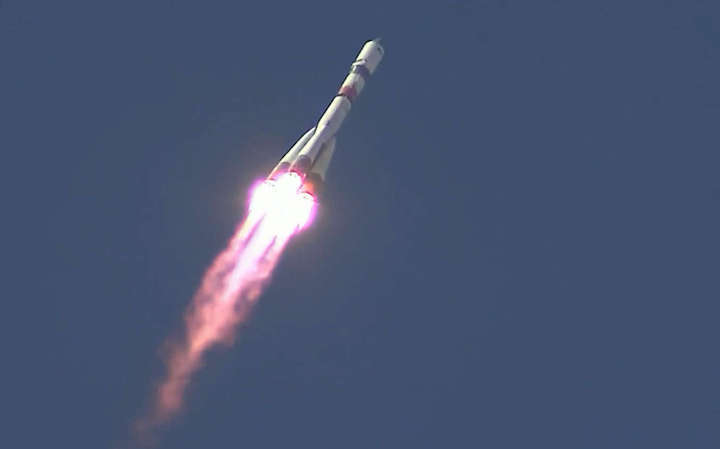3.06.2022
Russia’s Progress MS-20 cargo freighter lifted off Friday on a fast-track, three-and-a-half hour rendezvous with the International Space Station to deliver around three tons of fuel, food, and supplies for the lab’s seven-person crew.
The Progress supply ship launched from the Baikonur Cosmodrome in Kazakhstan at 5:32 a.m. EDT (0932 GMT) aboard a Soyuz-2.1a rocket. Russian ground crews rolled the Soyuz booster to the launch pad at Site 31 early Tuesday, then raised it vertical into liftoff position over the pad’s cavernous flame trench.

In the final hours before launch, Russian teams loaded kerosene and liquid oxygen into the Soyuz rocket, then retracted gantry arms to reveal the vehicle in the last half-hour of the countdown.
The rocket is marked with the word “Donbas,” the region of eastern Ukraine currently under attack by the Russian military. Russia’s space agency has added a “Z” insignia to several recent Soyuz rockets. The “Z” commonly associated with support for Russia’s military invasion of Ukraine.
The Soyuz main engines ignited and powered up to full full throttle to propel the launcher and the Progress cargo ship off the pad. The launch is timed for the moment when Earth’s rotation brings the Baikonur launch site under the space station’s flight path.
More than 900,000 pounds of thrust from the rocket’s engines powered the Soyuz downrange to the northeast from Baikonur. The rocket’s four first stage boosters shut down and jettisoned about two minutes after liftoff, followed by the separation of the aerodynamic shroud protecting the Progress spacecraft in the early phases of the launch.
The core stage, or second stage, fired for nearly five minutes, then separated to fall into a downrange impact area. A third stage engine finished the job of placing the Progress MS-20 supply ship into orbit, culminating in deployment of the cargo craft nearly nine minutes into the mission.
Solar arrays and navigation antennas were then unfurled on the Progress MS-20 spacecraft, which will perform a series of rendezvous burns to fine-tune its approach to the space station. The automated, radar-guided rendezvous concluded with a docking at the aft port of the station’s Zvezda service module at 9:02 a.m. EDT (1302 GMT).
The aft port was vacated Wednesday with the departure of the Progress MS-18 supply ship, which re-entered the atmosphere and burned up a few hours after leaving the station, disposing of several tons of trash.
The Progress MS-20 mission is known as Progress 81P in the space station’s schedule of visiting vehicles. It’s the 81st Russian Progress resupply mission to launch to the International Space Station.
Russia’s space agency said the Progress MS-20 cargo ship will deliver about 2.5 metric tons, or 5,500 pounds, of supplies, fuel, and drinking water to the station. The Progress spacecraft carries hydrazine and nitrogen tetroxide propellants to refuel the Zvezda service module.
The Russian supply ship will also reboost the orbital altitude of the space station, and perform any required burns to steer the station out of the path of space junk.

The Progress MS-20 resupply mission is the first of two cargo flights to the station planned in the next week.
SpaceX is readying a Dragon cargo capsule for launch on a Falcon 9 rocket June 10 from NASA’s Kennedy Space Center in Florida, carrying a NASA Earth science instrument, experiments, and other supplies to the space station.
Liftoff June 10 is scheduled for 10:22 a.m. EDT (1422 GMT), followed by an automated docking at the station’s U.S.-owned Harmony module June 12.
Quelle: SN
